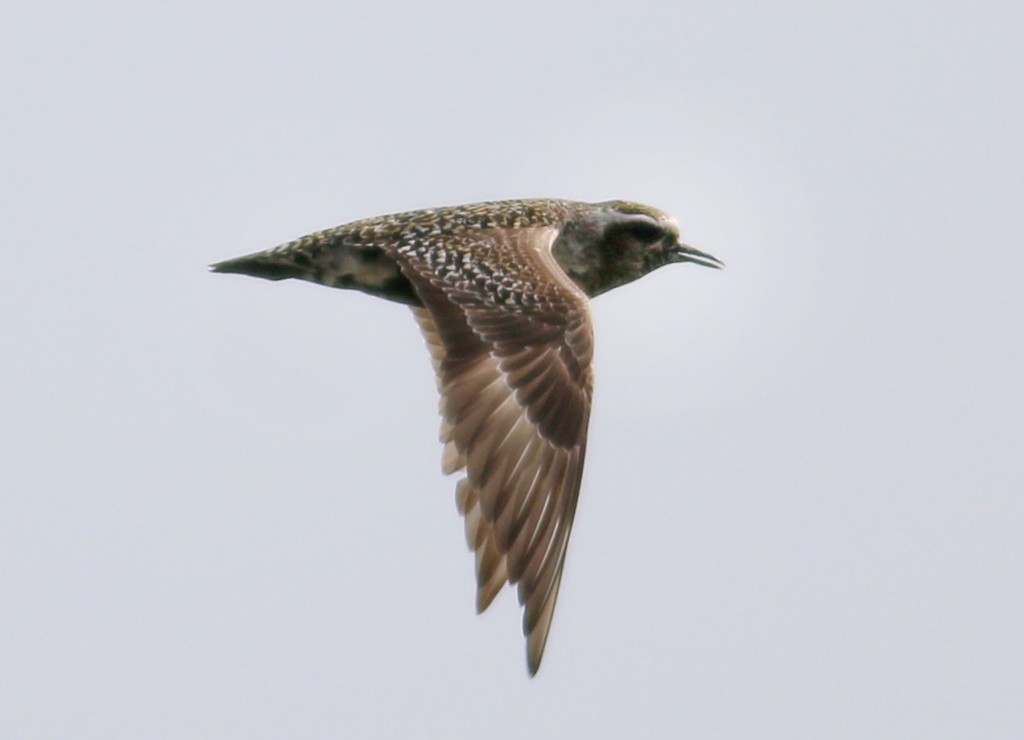It was the kind of day where I just had to go out birding. The skies were clear, the temperature was ideal (in the mid-80’s), and the winds were light and coming from the west. There HAD to be something good out there, right? And even if there wasn’t, it was a perfect day to search for them, so Jeanine and I ventured out to the Sedge Islands again.
The Sedges have been good to us this year. Every trip there yields good numbers and quality of birds at close range, and there’s always the possibility of a rarity. For me, an average day at the Sedges beats a good day almost anywhere else nearby. Today my sights were set on either American Golden-plovers, which are popping up at the sod farms in nearby counties, or on one of the really unusual terns.
We arrived later than usual, with the tide already rising. Our first pass through the main flats didn’t yield anything remarkable, with the highlight being a large gathering of 70 Royal Terns. We couldn’t turn any of them into a Sandwich Tern, like we did last week. At the inlet it was relatively quiet, although its always nice to see a flock of around 30 Brown Pelicans (‘normal’ for the Sedges), and a scraggly Red Fox patrolling the beach, trying to figure out how to convert one of the Common Terns into a meal. Returning back to the main flats, most of the birds now were concentrated into a relatively small area as it approached high tide. The goal of finding an American Golden-plover became more realistic upon seeing a sizeable flock of Black-bellied Plovers gathered on the edge of the water.

Here is a portion of the gaggle of Plovers that we found today. Can you spot the American Golden-plover in the crowd? It’s in there somewhere. We’ll come back to this photo later. Notice all the plumage stages on these plovers. Click on the photo for a larger version.
Jeanine and I spotted the bird at about the same time. I don’t always know what makes a tough bird stand out, but something stood out about this bird. The Cape May school of birding would just say that it was the GISS (or ‘jizz’) of the bird. Most of the time we prefer not to see an interesting bird walking away from us when we’re working on an ID, but in this case it was very helpful, since a definitive field mark is the black undertail of the American Golden-plover compared to the white undertail of the Black-bellied Plover. That sealed the case.

I’m not always hoping to see the underside of a bird, but in this case it was helpful to see those remaining black splotches on the undertail.
We tried to approach closer, but the bird had a comfort zone, and as soon as we approached 10 ft closer, it ambled 10 ft further away. It was a fun game that we repeated a few times (we sneak closer, it shimmies further; we try a different direction, it goes in a different direction, etc. etc.) , but ultimately we were happy with our views and switched to being distracted by the terns (more about them tomorrow).
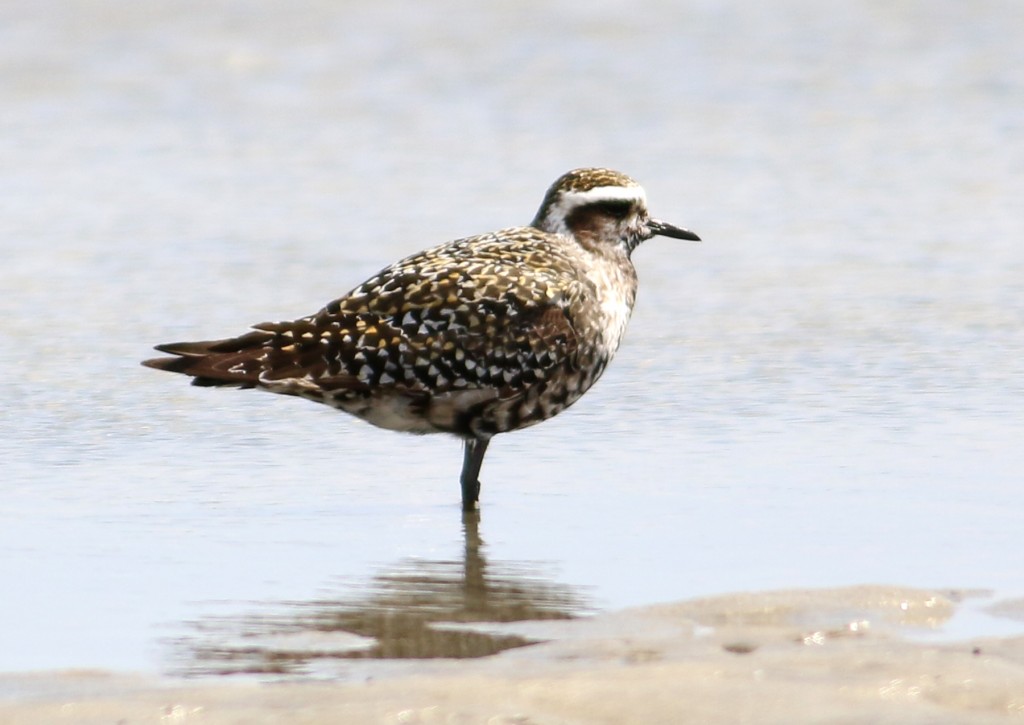
The field guide view of American Golden-plover. The combination of gold, brown, and white highlights on the feathers was delightful to view in person.
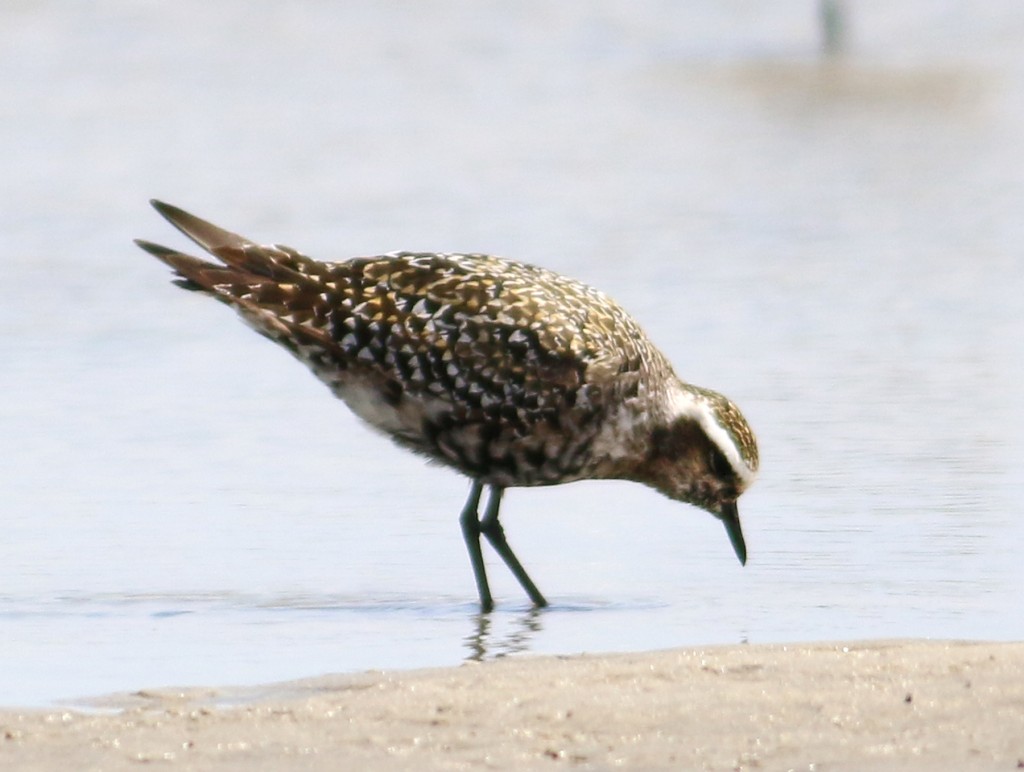
American Golden-plover feeding. Here you can see the undertail molting from black to white. Black-bellied Plovers have an all-white undertail.
Before we leave for today, it is worthwhile to compare American Golden-plover (AMGP) and Black-bellied Plover (BBPL) in more detail; what can we look for when trying to find an AMGP in a group of BBPLs? The field guides mention several field marks. American Golden-plover is a tad smaller and has a slightly smaller bill than Black-bellied Plover, but the size difference is very tough to distinguish unless you are fortunate to have a direct side-by-side comparison, and apparent size changes depending upon posture. I would consider size a secondary trait, and not one that I would use to scan through a flock. The bill size can be particularly important when the birds have completed their molt into non-breeding plumage, but again, it would be tough to use as the primary search criterion. As we mentioned earlier, the undertail color is important, but relies upon at least some remnant of breeding plumage. If the birds are in breeding plumage, this would be a good mark to search for, but it requires that they are facing sideways or away from the birder. For example, in the photo at the top of this post, all the birds are facing into the wind towards the camera, so the undertail is not visible. In flight, the underwing pattern is definitive, but that often relies up on a fleeting glimpse. All of these field marks help. Searching for golden tones to the feathers doesn’t work for me, since that seems very lighting-dependent and plumage dependent. For example, a flock of Black-bellied Plovers at this time of year can have some individuals that look nearly gray and other that have a tinge of brown. I think that we can all agree that in the photo below, even the Black-bellied Plover looks somewhat golden.
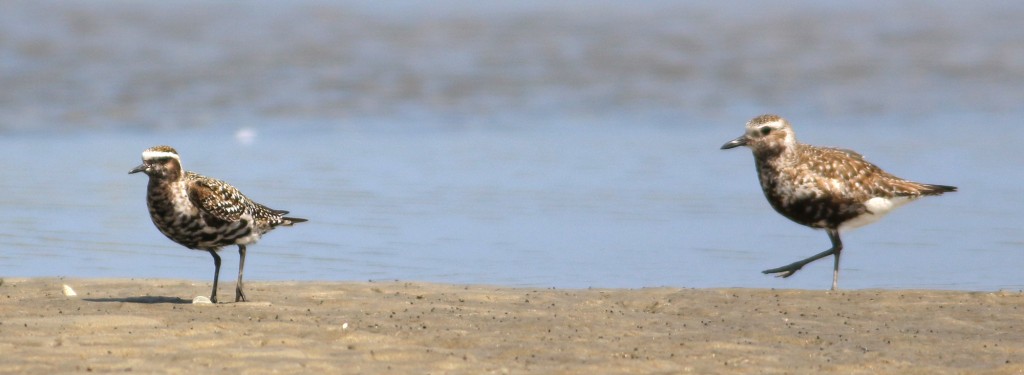
Here’s a pretty nice side-by-side comparison of an American Golden-plover on the leftt, with the more common Black-bellied Plover. Note the slightly smaller size, smaller bill, and speckled undertail of the American Golden-plover.
So what is the best field mark to start with? For me, the quickest way to scan through a mixed flock is to search for the bird with the prominent white supercilium that highlights a darker cap. Let’s re-examine the original photo that was at the top of this blog entry. Click on the photo below for a larger version, and then scan quickly looking for that bold supercilium and see if you can find the AMGP now.

Can you spot the American Golden-plover in this crowd? Click on the photo to get a larger version, and look for the prominent white supercilium.
OK, in the next photo the group has shifted slightly, and the bird is now more obvious, with the spotted undertail visible and the shorter bill. See, it’s not that hard after all, is it?
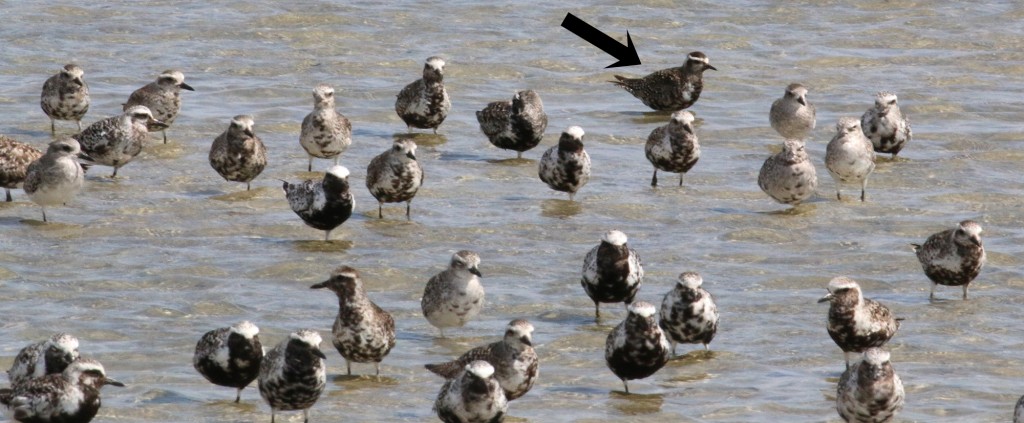
OK, now that it turned sideways and I added an arrow, the American Golden-plover is more obvious. Click on the photo for a larger version.
This was the first American Golden-plover reported in the county this year, and there were only two reports in 2016. So it definitely qualifies as a nice find.
